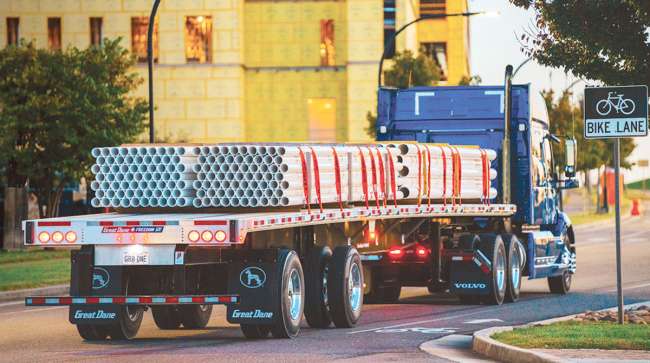Staff Reporter
ATA Reports Dip in Truck Tonnage for June

[Stay on top of transportation news: Get TTNews in your inbox.]
The trucking industry resumed a trend of year-over-year tonnage losses in June after a brief increase the prior month, American Trucking Associations reported July 23.
The ATA For-Hire Truck Tonnage Index slipped 0.4% year-over-year to 113.5, ending a short-lived increase in May that had halted 15 consecutive months of year-over-year losses. The June results also reflected a 1.6% decrease sequentially from the prior month.
“While giving back some of the gain from May, it appears that truck freight tonnage is slowly going in the right direction since hitting a recent low in January,” ATA Chief Economist Bob Costello said. “Despite June’s decline, the second-quarter average was 0.2% above the first quarter and only 0.2% below the second quarter in 2023, which are good signs that truck freight might be finally turning the corner.”
ATA calculates its monthly tonnage index by surveying its membership. The feedback primarily comes from contract freight rather than spot market freight. In calculating the index, 100 represents the year 2015.

Phares
“The ATA’s numbers are a little bit more in line with some of the other economic indexes that we see,” said Jonathan Phares, assistant professor of supply chain management at Iowa State University. “In June we saw the Cass Freight Index was down again just like it was last month. Employment decreased, new jobs decreased in June as well.”
The Cass Freight Index reported that its shipments reading decreased 6% year-over-year to 1.078 from 1.147. The figure also declined 1.8% sequentially from the 1.098 reported in May. The index concluded that in-sourcing of freight from private fleet capacity additions is the main driver of the year-over-year decline in for-hire volumes.
“The phrases that you hear around here a lot lately are slow and sluggish,” said Tim Denoyer, senior analyst at ACT Research and author through a partnership of the Cass report.
Denoyer noted signs of slight demand recovery in the spot market, which he said aligns with general consumer trends that are showing signs of slow growth that suggest an eventual recovery.
“We are seeing growth overall,” he said. “I think the main reason that Cass is still down from a volume perspective is that private fleets are just still adding capacity. But, I think there is generally a little bit of growth out there. And there’s a lot of mixed signals at the moment.”
Denoyer added, “We do also worry about this private fleet capacity additions, and we think when that ends it’ll really help for-hire demand to recover, and we think that’s slowing.”
[June 2024 Cass Information Systems Index Report] - Closing in on Balance
— ACT Research (@actresearch) July 15, 2024
Read the full report 👉https://t.co/EzTOQunSwx#freight #logistics #TL #LTL #shipping #trucking #transportation, #ACTResearch, #ACT pic.twitter.com/SlbiePEUeH
Rajeev Dhawan, director of the Economic Forecasting Center at Georgia State University, warned that as inflation starts to slow the downside will be a resulting slowdown in the economy. And that, he said, means demand for products and freight will also slow down.
“When inflation was running 7% to 9% a few years ago, the economy was booming,” Dhawan said. “It was beyond the capacity and the freight demand was at the peak. Now that the Federal Reserve has raised the rates, the freight demand has come down because the economy is slow.”
Dhawan projects that the economy is headed for a soft landing, but stressed that trends should be monitored for indications of potential changes in that trajectory. He pointed specifically to the airline industry, as any softening of their pricing power could be a possible indicator that consumer demand is moderating.
Jeff Loftus of FMCSA joins TT’s Seth Clevenger to discuss the current outlook on ADAS technology and how it will affect the industry at large. Tune in above or by going to RoadSigns.ttnews.com.
“They’re not very confident that this urge to travel — which was there after the pandemic ended, and this was the first proper summer — can be maintained at the same rate going forward,” Dhawan said. “There is going to be moderation, and that is one activity that was keeping the consumption numbers looking very good. Because when you travel you stay in a hotel, you eat, you do sightseeing — you do the other stuff that generates a demand for products.”
Iowa State’s Phares stressed that there remains a lack of predictability with current freight cycles, even as overall weakness appears to be easing.
“It would be really good to see over the next few months whether it starts to even out a bit because the last few months have just been so much more variable and dynamic than they have been over the past few years,” Phares said. “A wait-and-see approach is probably a bit better before we can make a real good judgment of what’s coming.”
Want more news? Listen to today's daily briefing below or go here for more info:





